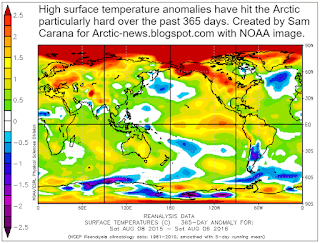A temperature rise (from preindustrial levels) of more than 10°C (18°F) could eventuate by the year 2026, as illustrated by the image below and as discussed in an earlier post.
The high temperature anomaly that occurred in February 2016 was partly caused by El Niño. Nonetheless, there is a threat that the February 2016 anomaly was not a peak, but instead was part of a trend that points at what is yet to come.
Ocean Heat
As the image below shows, 93.4% of global warming goes into oceans. Accordingly, ocean heat has been rising rapidly and, as the image below shows, a trend points at a huge rise over the coming decade.
Ocean temperature rise affects the climate in multiple ways. A recent study confirmed earlier fears that future increases in ocean temperature will result in reduced storage of carbon dioxide by oceans.
Arctic Sea Ice Thickness & Volume
 |
| [ click on images to enlarge] |
Arctic sea ice is losing thickness rapidly. The image on the right shows that the thicker sea ice is now almost gone (image shows sea ice on August 6, 2016, nowcast). The image below gives a comparison of the years 2012, 2013, 2014 and 2015 for August 6.
The situation looks even more threatening when looking at the Naval Research Laboratory image below, produc ed with a new model and run on August 3, 2016, valid for August 4, 2016.
The image below, by Jim Pettit, shows Arctic sea ice volume.
 |
| animated version of this graph |
The extra heat entering the oceans translates in a huge temperature rise at the sea surface, as illustrated by the image below, from an earlier post and using sea surface temperature anomalies on the Northern Hemisphere up to November 2015.

 |
| [ click on images to enlarge ] |
Note that the anomalies are reaching the top of the scale, so in some areas they will be above that top end (i.e. 4°C or 7.2°F) of the scale.
Sea surface temperatures off the coast of North America are very high, with sea surface temperatures as high as 33.1°C, as the image below shows. Much of the heat accumulating in the Gulf will be carried by the Gulf Stream to the Arctic Ocean over the coming months.
Sea surface temperatures in the Arctic Ocean will remain around freezing point, where and for as long as there still is sea ice present. Once the sea ice is gone, though, sea surface temperature in that area will rise rapidly.
The image below shows how profound sea surface temperature anomalies are at higher latitudes of the Northern Hemisphere.
While sea surface temperatures can be huge locally, even warmer water may be carried underneath the sea surface from the Atlantic Ocean into the Arctic Ocean, due to the cold freshwater lid on the North Atlantic, as illustrated by the image below, from an earlier post.
 |
| feedback #28 at the feedback page |
Surface Temperature
As the image on the right shows, high surface temperature anomalies have hit the Arctic particularly hard over the past 365 days.
Apart from melting the sea ice from above, high temperatures over land will also warm up the water of rivers that end in the Arctic Ocean.
Warm water from rivers will thus contribute (along with wamer water brought into the Arctic Ocean from the Atlantic and Pacific Oceans) to melting of the Arctic sea ice from below.
Methane
There's a danger that, as the temperature of the Arctic Ocean keeps rising, huge amounts of methane will enter the atmosphere due to destabilization of hydrates at its seafloor.
The situation is dire and calls for comprehensive and effective action as described in the Climate Plan.
Links
• A Global Temperature Rise Of More than Ten Degrees Celsius By 2026?
http://arctic-news.blogspot.com/2016/07/a-global-temperature-rise-of-more-than-ten-degrees-celsius-by-2026.html
• Ocean Heat
http://arctic-news.blogspot.com/2015/11/ocean-heat.html
• Implications for Earth’s Heat Balance, IPSS 2007
http://www.ipcc.ch/publications_and_data/ar4/wg1/en/ch5s5-2-2-3.html
• World Ocean Heat Content and Thermosteric Sea Level change (0-2000 m), 1955-2010, by Levitus et al.
http://onlinelibrary.wiley.com/doi/10.1029/2012GL051106/abstract
• Attenuation of sinking particulate organic carbon flux through the mesopelagic ocean, by Marsay et al.
http://www.pnas.org/content/112/4/1089





























